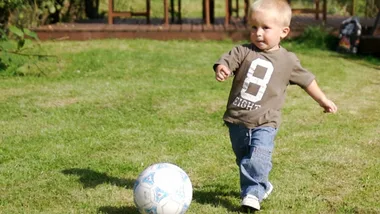Jumping may not seem like a truly remarkable feat, but clearing a puddle requires balance, strength and the precise coordination of arms, knees and hips.
Throughout their primary school years, a child’s jump abilities increase an awe-inspiring average of 7-12cm in distance and 5cm in height per year.
Kids learn to jump soon after they learn to run, usually starting at about 24 months. First a child will try taking a single step down a stair; next she’ll explore other kinds of objects that are jump-offable, then overable, then aroundable.
At about 30 months, once kids have the leg strength to defy gravity, and have started to master the sense of balance they need for landing, jumps become more sophisticated. They may experiment with bunny hops, for instance, that move the jumper not just up but forward, too.
By four or five, a child enters the golden era of physical mastery (they may even be riding a bike), coordinating arms with the extension of their legs and torso as they jump, resulting in a long jump with serious distance. It’s a skill she’ll call on to launch herself over a puddle instead of into it – that is, of course, unless her brother stands close enough to benefit from the splash.


